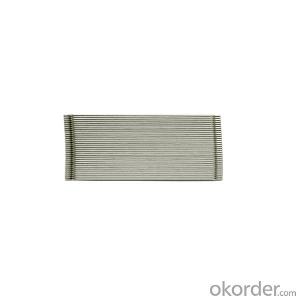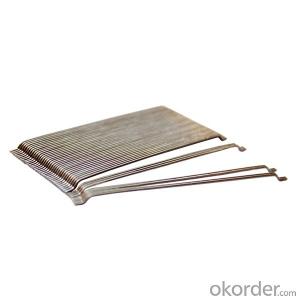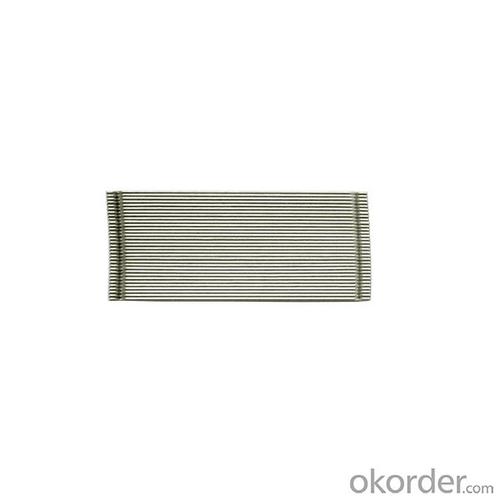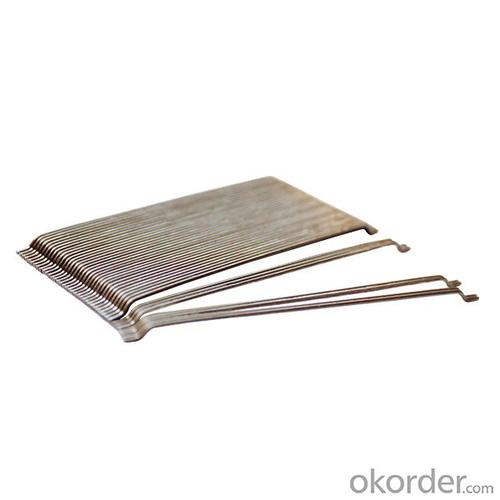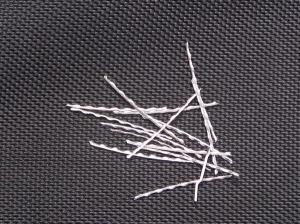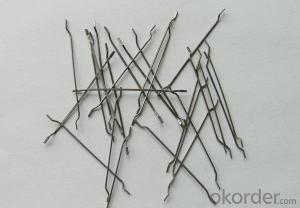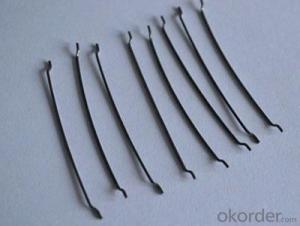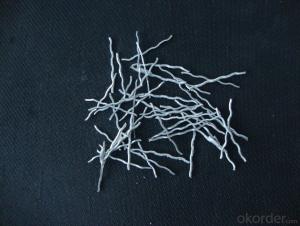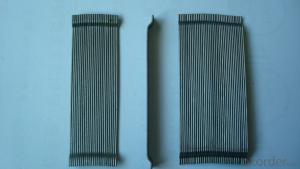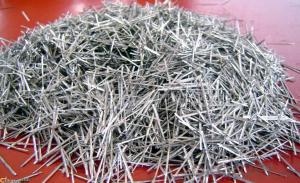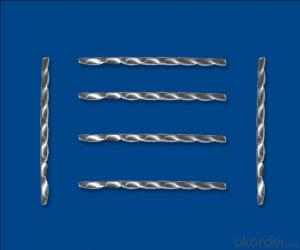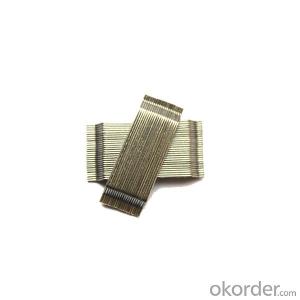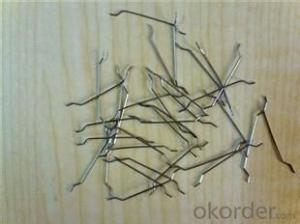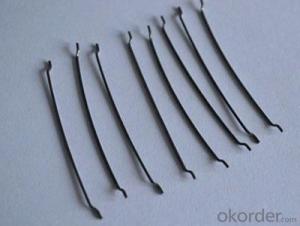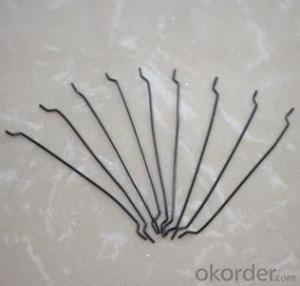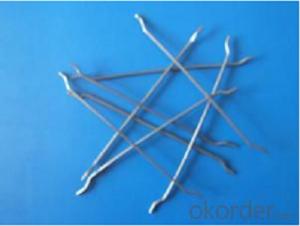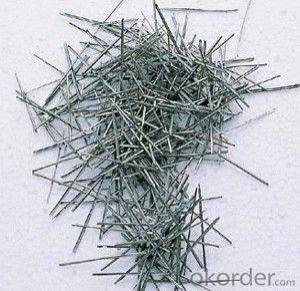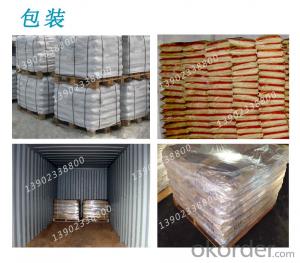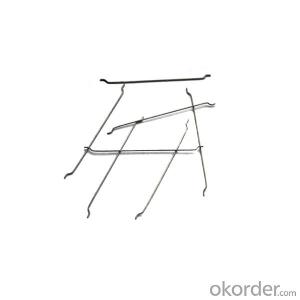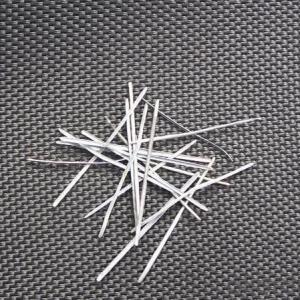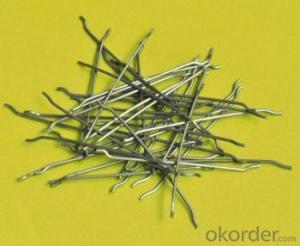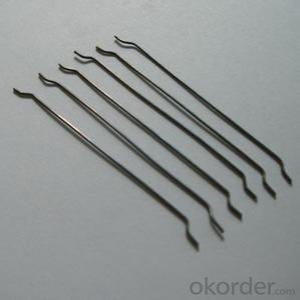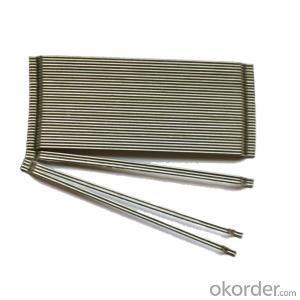Melt Extract Stainless Steel Fiber Concrete Steel Fiber 0.75/50 from CNBM China
- Loading Port:
- Tianjin
- Payment Terms:
- TT OR LC
- Min Order Qty:
- 1 m.t.
- Supply Capability:
- 5000 m.t./month
OKorder Service Pledge
Quality Product, Order Online Tracking, Timely Delivery
OKorder Financial Service
Credit Rating, Credit Services, Credit Purchasing
You Might Also Like
Quick Details
Place of Origin: Tianjin, China (Mainland)
Model Number: 0.75
Material: Steel
Production Process: Cold drawn
Lengh: 50
Type: 1
Compressive Strength: >1200MPa
Aspect ratio: 66
Standard: ASTM A820M-11
Section Shape: Circular
Application: Concrete Reinforcement
Packaging & Delivery
| Packaging Details: | 20 kg/Bag,50 bags/Pallet or 1,000kg/ Bulk Bag |
|---|---|
| Delivery Detail: | 1 Month |
Product Description
| Diameter | 0.75 | mm | 0.03 | in |
| Length | 50.00 | mm | 1.96 | in |
| Aspect Ratio | 67 | |||
| Tensile strength | 1200 MPa | |||
| Type | Cold drawn Steel Fiber | |||
| End | Hooked-end Steel Fiber | |||
| Glued/Loose | Glued Steel Fiber | |||
| Bending Angle | 45°(min.30°) | |||
| Usage & Performance | Floor:Trafficked areas and Industrial floors | |||
| Shotcrete :Slope stabilization and Final lining | ||||
| Precast concrete:Pipe and Railway sleepers | ||||
| Packing | Standard Export Pallet Packing | Bag Packing | 20 kg/Bag,50 bags/Pallet | |
| Bulk Packing | 1,000kg/ Bulk Bag | |||
| Loading Quantity | 20’GP | 20-25 Tonne/Tonnes | ||
| 40’GP | 25-27 Tonne/Tonnes | |||
| 40’HQ | 25-27 Tonne/Tonnes | |||
| MOQ | 1 kg for trial order | |||
| Supply Ability | 10,000 Tonne/Tonnes per Year | |||
| Payment Terms | T/T or L/C at sight | |||
| Delivery Time | Within 15 days after receiving deposit or original L/C at sight | |||
| Certification | ISO9001:2000, CE, | |||
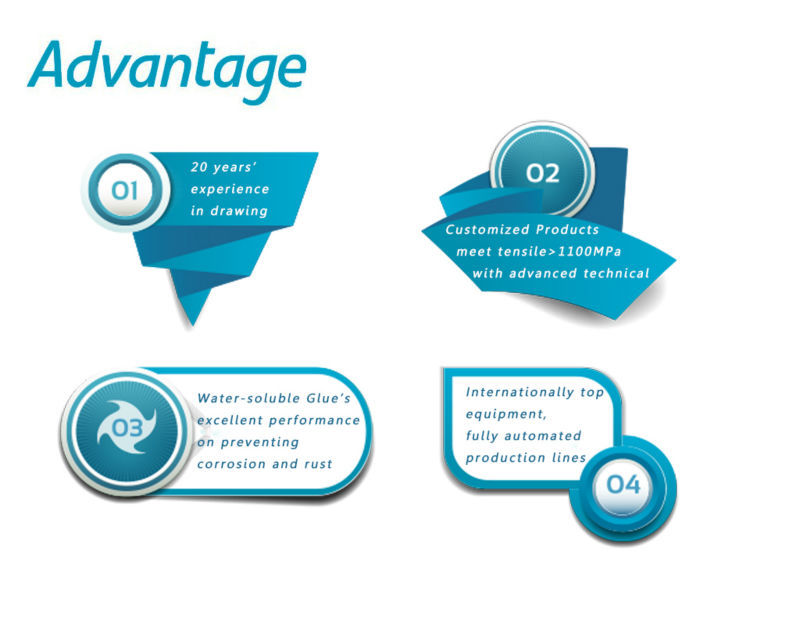
| Product | Diameter | Length mm/in | Aspect Ratio | Type | Packing |
| G-6030 | 0.5 mm (0.0197 in) | 30 mm (1.1811 in) | 60 | Glued | 20 kg/Bag, or 1,000kg/ Bulk Bag |
| G-6535 | 0.55 mm (0.0217 in) | 35 mm (1.3780 in) | 65 | Glued | 20 kg/Bag, or 1,000kg/ Bulk Bag |
| G-6035 | 0.6 mm (0.0236 in) | 35 mm (1.3780 in) | 60 | Glued | 20 kg/Bag, or 1,000kg/ Bulk Bag |
| G-8060 | 0.75 mm (0.0295 in) | 60 mm (2.3622 in) | 80 | Glued | 20 kg/Bag, 50 bags/Pallet |
| G-6060 | 0.9 mm (0.0354 in) | 60 mm (2.3622 in) | 60 | Glued | 20 kg/Bag, 50 bags/Pallet |
| G-6030 | 0.5 mm (0.0197 in) | 30 mm (1.1811 in) | 60 | Loose | 20 kg/Bag, or 1,000kg/ Bulk Bag |
| G-6535 | 0.55 mm (0.0217 in) | 35 mm (1.3780 in) | 65 | Loose | 20 kg/Bag, or 1,000kg/ Bulk Bag |
| G-6035 | 0.6 mm (0.0236 in) | 35 mm (1.3780 in) | 60 | Loose | 20 kg/Bag, or 1,000kg/ Bulk Bag |
| G-8060 | 0.75 mm (0.0295 in) | 60 mm (2.3622 in) | 80 | Loose | 20 kg/Bag, 50 bags/Pallet |
| G-6060 | 0.9 mm (0.0354 in) | 60 mm (2.3622 in) | 60 | Loose | 20 kg/Bag, 50 bags/Pallet |
- Q: How does melt extract stainless steel fiber contribute to the crack control of concrete?
- Melt extract stainless steel fiber enhances the crack control of concrete by acting as reinforcement within the material. The fibers are uniformly distributed throughout the concrete matrix, creating a three-dimensional network that helps to distribute loads and inhibit the propagation of cracks. This reinforcement improves the overall tensile strength and ductility of the concrete, reducing the formation and widening of cracks. Additionally, the stainless steel fibers can effectively bridge small cracks, preventing them from developing into larger, more significant cracks.
- Q: How does melt extract stainless steel fiber improve the resistance of concrete to impact loads?
- The impact resistance of concrete is improved by the addition of melt extract stainless steel fiber in various ways. Firstly, the tensile strength and ductility of the concrete are significantly enhanced by the inclusion of stainless steel fibers. Acting as reinforcement, these fibers distribute the applied load more evenly throughout the concrete and reduce the concentration of stress points, thus preventing crack formation and propagation and increasing the overall impact resistance of the concrete. Furthermore, the unique properties of stainless steel, including high strength, corrosion resistance, and durability, contribute to the improved impact resistance of the concrete. The stainless steel fibers are extremely tough and can withstand high impact forces without breaking or deforming. This toughness allows them to effectively absorb and dissipate energy during impact, preventing catastrophic failure. In addition, the small size and high aspect ratio of the melt extract stainless steel fibers promote better bonding with the concrete matrix. This strong bond ensures that the fibers remain securely anchored within the concrete, even under high impact loads. Consequently, the overall strength and integrity of the concrete are increased, making it more resistant to damage caused by impacts. Moreover, the addition of stainless steel fibers can also enhance the behavior of concrete after cracking. In the event of cracks occurring due to impact loads, the fibers help to hold the cracked sections together, preventing further separation and limiting the extent of damage. This post-cracking behavior further contributes to the overall improvement in the impact resistance of the concrete. To summarize, melt extract stainless steel fiber improves the impact resistance of concrete by enhancing its tensile strength, ductility, and toughness. The fibers ensure a more uniform distribution of applied loads, prevent crack formation and propagation, and provide a strong bond with the concrete matrix. Additionally, they are capable of absorbing and dissipating energy during impact and contribute to the post-cracking behavior of the concrete.
- Q: Can melt extract stainless steel fiber be used in railway sleepers?
- Yes, melt extract stainless steel fiber can be used in railway sleepers. Stainless steel fiber is a high-strength material that offers excellent resistance to corrosion and fatigue. Its use in railway sleepers can enhance the overall strength and durability of the sleepers, making them suitable for heavy train loads and prolonged service life. The melt extract process ensures that the stainless steel fibers have a uniform and consistent shape, which further enhances their performance and reliability. Additionally, the use of stainless steel fiber can help prevent the formation of cracks and improve the resistance to thermal expansion and contraction, making it an ideal choice for railway sleepers.
- Q: Can melt extract stainless steel fiber be used in fiber-reinforced polymers?
- Yes, melt extract stainless steel fiber can be used in fiber-reinforced polymers (FRPs). Stainless steel fibers are often added to polymer matrices to enhance their mechanical properties such as tensile strength, flexural strength, and impact resistance. The melt extract stainless steel fibers are obtained through a specialized process that ensures uniformity and high quality. The addition of stainless steel fibers to FRPs can provide several benefits. Firstly, the fibers can enhance the overall strength and durability of the composite material, making it suitable for applications that require high strength-to-weight ratio. Secondly, stainless steel fibers can improve the fracture toughness of the FRPs, making them more resistant to crack propagation. This can be particularly important in applications where impact resistance is crucial. Additionally, the corrosion resistance of stainless steel fibers can be advantageous in environments where the FRPs may be exposed to harsh conditions, such as moisture, chemicals, or high temperatures. The stainless steel fibers can prevent corrosion of the composite material, increasing its lifespan and reliability. Overall, the use of melt extract stainless steel fibers in fiber-reinforced polymers can significantly enhance the mechanical properties and durability of the composite material, making it suitable for a wide range of applications in industries such as automotive, construction, aerospace, and marine.
- Q: Does melt extract stainless steel fiber enhance the bond strength between concrete layers?
- The inclusion of melt extract stainless steel fiber indeed heightens the bond strength between layers of concrete. By incorporating stainless steel fibers into concrete mixtures, the mechanical properties, specifically the bond strength between layers, are enhanced. As the concrete solidifies, the stainless steel fibers disperse evenly throughout the mixture, reinforcing it and augmenting the overall strength. This reinforcement fortifies the bond between layers, rendering it more resilient against cracking, delamination, and other forms of failure. Additionally, the integration of melt extract stainless steel fibers can enhance the durability and longevity of the concrete structure by diminishing the risk of spalling and increasing its resistance to impacts and vibrations. Ultimately, the utilization of melt extract stainless steel fiber in concrete significantly improves the bond strength between layers, elevating the performance and lifespan of the concrete structure.
- Q: Can melt extract stainless steel fiber replace traditional reinforcement in concrete structures?
- Yes, melt extract stainless steel fiber can be used as a replacement for traditional reinforcement in concrete structures. Stainless steel fibers provide several advantages over traditional reinforcement, such as increased strength and durability. These fibers are added to the concrete mix during the mixing process, distributing evenly throughout the entire structure. The use of stainless steel fibers can help in reducing or eliminating the need for traditional reinforcement methods like steel bars or mesh. This can lead to cost savings, as the installation of steel bars or mesh can be time-consuming and expensive. Additionally, stainless steel fibers offer better crack control, as they can effectively distribute and restrain cracks that occur in the concrete. This can enhance the overall performance and longevity of the structure. Moreover, stainless steel fibers are corrosion-resistant, which is a significant advantage over traditional reinforcement. Steel bars or mesh can corrode over time, leading to structural deterioration. By using stainless steel fibers, the risk of corrosion-related damage is greatly reduced. However, it is important to note that the use of stainless steel fibers as a replacement for traditional reinforcement should be evaluated on a case-by-case basis. Factors such as the type and scale of the structure, the loading conditions, and the required design life should be considered. Consulting with structural engineers and following proper design guidelines and codes is essential to ensure the successful use of stainless steel fibers as reinforcement in concrete structures.
- Q: How does melt extract stainless steel fiber improve the resistance to aging in asphalt mixtures?
- The resistance to aging in asphalt mixtures is improved by melt extract stainless steel fiber in various ways. Firstly, the overall strength and durability of the asphalt mixture are enhanced by adding stainless steel fiber. This increased strength enables the pavement to withstand repetitive loads and traffic stresses, reducing the likelihood of premature cracking, rutting, or other forms of distress. Moreover, stainless steel fiber acts as a reinforcement within the asphalt matrix, preventing crack propagation and reducing aging-related damage. These fibers create a three-dimensional network that distributes stress more evenly throughout the mixture, minimizing stress concentration at specific points and increasing resistance to deformation. Additionally, the presence of stainless steel fiber improves resistance to temperature variations in asphalt mixtures. It helps mitigate the effects of thermal expansion and contraction, reducing the risk of thermal cracking and enhancing long-term pavement performance. Furthermore, stainless steel fiber exhibits excellent corrosion resistance properties. This means that even in harsh environmental conditions, such as moisture or exposure to deicing salts, the fibers will not corrode or degrade over time. This corrosion resistance greatly contributes to improved aging resistance, as it ensures the reinforcing effect of the fibers remains intact throughout the lifespan of the asphalt pavement. In conclusion, melt extract stainless steel fiber enhances resistance to aging in asphalt mixtures by improving overall strength and durability, preventing crack propagation, reducing deformation, mitigating thermal cracking, and providing excellent corrosion resistance. These advantages result in a longer lifespan and improved performance of the asphalt pavement, ultimately saving costs and enhancing the safety and comfort of road users.
- Q: How does melt extract stainless steel fiber affect the shrinkage of concrete?
- Melt extract stainless steel fiber can have a significant impact on the shrinkage of concrete. When added to concrete mixtures, these fibers help to reduce the overall shrinkage of the material. This is due to the unique properties of stainless steel fibers, such as their high tensile strength and low thermal expansion coefficient. During the curing process, concrete undergoes a chemical reaction called hydration, where water reacts with the cement to form a solid matrix. As this reaction takes place, the water evaporates, causing the concrete to shrink. This shrinkage can lead to cracking and decreased durability of the concrete structure. However, the addition of melt extract stainless steel fibers helps to mitigate this issue by providing reinforcement within the concrete matrix. These fibers act as reinforcement bars, distributing the stresses created by shrinkage more evenly throughout the concrete. As a result, the overall shrinkage and subsequent cracking are reduced. Furthermore, the low thermal expansion coefficient of stainless steel fibers helps to minimize the effects of temperature changes on the concrete. Temperature fluctuations can cause concrete to expand and contract, leading to additional shrinkage and potential cracking. The stainless steel fibers help to limit these movements, maintaining the integrity of the concrete structure. In summary, melt extract stainless steel fibers positively affect the shrinkage of concrete by reducing overall shrinkage and mitigating the potential for cracking. Their high tensile strength and low thermal expansion coefficient make them an effective reinforcement material, enhancing the durability and longevity of concrete structures.
- Q: What is the effect of melt extract stainless steel fiber on the crack propagation in concrete?
- The primary effect of melt extract stainless steel fiber on crack propagation in concrete is to enhance crack resistance and improve the overall durability of concrete structures. When stainless steel fibers are incorporated into concrete, they create a three-dimensional reinforcement network that promotes a more even distribution of stress throughout the concrete matrix. By dispersing the load and reducing stress concentration at vulnerable points like cracks or weak zones, the stainless steel fibers effectively hinder crack propagation. Acting as micro-reinforcements within the concrete, these fibers bridge cracks and prevent them from spreading further. Stainless steel fibers possess unique properties such as high tensile strength, corrosion resistance, and ductility, which make them particularly effective in boosting concrete's crack resistance. Unlike other fiber types, stainless steel fibers can withstand high tensile stresses and maintain their integrity even in extreme conditions like freeze-thaw cycles or exposure to chemicals. Moreover, the manufacturing process of melt extract stainless steel fibers ensures a high aspect ratio, providing a large surface area for interaction with the surrounding concrete matrix. This increased bond between the fibers and the concrete matrix further enhances crack resistance. Overall, the inclusion of melt extract stainless steel fibers in concrete significantly improves its ability to resist cracking and enhances its durability. Consequently, this leads to extended service life, reduced maintenance expenses, and enhanced safety for concrete structures in various applications such as buildings, bridges, pavements, and tunnels.
- Q: What is the recommended spacing between melt extract stainless steel fibers in concrete?
- The recommended spacing between melt extract stainless steel fibers in concrete typically ranges from 1 inch to 2 inches.
Send your message to us
Melt Extract Stainless Steel Fiber Concrete Steel Fiber 0.75/50 from CNBM China
- Loading Port:
- Tianjin
- Payment Terms:
- TT OR LC
- Min Order Qty:
- 1 m.t.
- Supply Capability:
- 5000 m.t./month
OKorder Service Pledge
Quality Product, Order Online Tracking, Timely Delivery
OKorder Financial Service
Credit Rating, Credit Services, Credit Purchasing
Similar products
Hot products
Hot Searches
Related keywords
